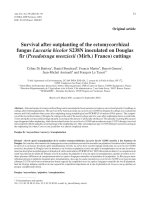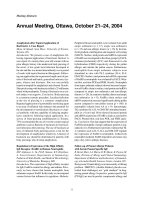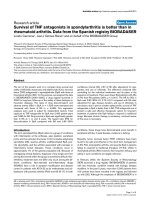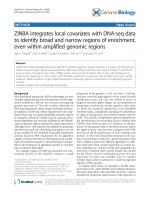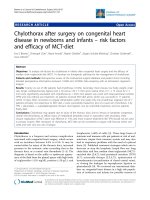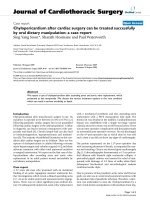Báo cáo y học: "Survival after prolonged resuscitation with 99 defibrillations due to Torsade De Pointes cardiac electrical storm: a case report" ppt
Bạn đang xem bản rút gọn của tài liệu. Xem và tải ngay bản đầy đủ của tài liệu tại đây (1.29 MB, 4 trang )
CAS E REP O R T Open Access
Survival after prolonged resuscitation with 99
defibrillations due to Torsade De Pointes cardiac
electrical storm: a case report
Anders Rostrup Nakstad
1*
, Christian Eek
2
, Dag Aarhus
3
, Anne Larsen
4
, Kristina Hermann Haugaa
2
Abstract
A 48-year-old previously healthy woman suffered witnessed cardiac arrest in hospital. She achieved return of spon-
taneous circulation and was transferred to the intensive care unit. During the following 3 hours, she suffered a car-
diac electrical storm with 98 episodes of Torsade de Pointes ventricular tachycardia rapidly degenerating to
ventricular fibrillation. She was converted with a total of 99 defibrillations. There was no response to the use of any
recommended anti arrhythmic drugs. However, the use of bretylium surprisingly stabilized her heart rhythm and
facilitated placing of a temporary pacemaker. Overdrive pacing prevented further arrhythmias and was life saving.
A number of beneficial factors may have contributed to the good neurological outcome. Further investigations
gave no explanation for her cardiac electrical storm.
Background
Torsade de Pointes (TdP) cardiac electrical storm may
be defined as the occurrence of more than two distinct
episodes of destabilizing TdP in 24 hours [1,2]. It is a
rare but challenging medical emergency and effective
treatment may be difficult, especially when TdP degen-
erates to VF or when the arrhythmia is a symptom of
underlying cardiac disease [3]. TdP ventricular tachycar-
dia was first described in 1966 [4]. A number of causes
are associated with TdP, including inherited long QT-
syndrome, female gender and some acqui red cond itions
like use of anti-arrhythmic drugs (e specially class Ia and
III), electrolyte disturbances, heart failure, subarachnoi-
dal haemorrhage and hypothermia [2,5]. Magnesium sul-
fate is recommended as the first line of therapy, in
addition to beta-blocker therapy [6-8]. In this report we
describe a case were a previously healthy woman suf-
fered a dramatic period of multiple events with TdP
degenerating to VF.
Case presentation
A 48-year-old woman was admitted to the neurological
department due to sudden loss of consciousness and
seizures from which she had recovered spontaneously.
The p rimary survey revealed no cardiac or neurological
abnormalities, and she was tentatively diagnosed to have
suffered from an epileptic seizure. She r eported to have
experienced a similar incident one month prior to
admission. This self-limiting seizure was witnessed by a
relative. She had no other history of disease or discom-
fort of any kind.
Figure 1 illustrates the time-line of events. Approxi-
mately two hours after admittance she was found pulse-
less in the ward. Basic cardiopulmonary resuscitation
(CPR) was immediately started. A resuscitation team
arrived after approximate ly 2 minute s and successf ully
defibrillated a VF into sinus rhythm. Return of sponta-
neous circulation (ROSC) was confirmed but the patient
did not regain consciousness. She was intubated and
transferred to the Intensive Care Unit (ICU) where ther-
apeutic hypothermia was initiated, in compliance with
current recommendations [9]. Arterial line, central
venous line, twelve-lead ECG, controlled mechanical
ventilation and capnography were established. She was
sedated with midazolam and fentanyl. Cooling was
initiated by use of external cold blankets and infusion
with Ringer’s solution (4°C) at a rate of 100 ml per min-
ute via a peripheral venous line [10].
Ninety minutes after her first cardiac arrest in the
ward - with an oesophageal temperature of 36.8°C - she
* Correspondence:
1
Department of Anesthesia and Air Ambulance Department, Oslo University
Hospital - Ullevål, Oslo, Norway
Nakstad et al . Scandinavian Journal of Trauma, Resuscitation and Emergency Medicine 2010, 18:7
/>© 2010 Nakstad et al; licensee BioMed Central Ltd. This is an Open Access article distributed und er the terms of the Creative Commons
Attribution License ( which permits unrestricted use, distribution, and reproduction in
any medium, provided the origina l work is prop erly cited.
suffered a new event of ventricular arrhythmia. Immedi-
ate chest compressions were started and charging of the
defibrillator initiated. Manual chest compressions main-
tained a systolic blood pressure of above 90 mmHg and
adequate signal qu ality on the peripheral pulse oximeter
was noticed. Adhesive pads were placed in standard
positions (apex and upper right chest). A defibrillator
with biphasic delivery of 150 Joule was used and suc-
cessful defibrillation into sinusrhythmachievedonthe
first attempt.
During the next 150 minutes the patient suffered from
repetitive episodes of ventricular arrhyth mia with an
initial pattern of TdP that degenerated into VF. This
pattern was typical for all subsequent arrhyt hmic events
(Figure 2). Each event triggered immediate chest com-
pressions for 20-30 s while charging the defibrillator.
Each shock successfully converted her to sinus rhythm
inallbutonecase(wherethesecondshockwassuc-
cessful) with rapid no rmalization of invasive blood pres-
sure values. The defibrillator was connected to a 220V
DC outlet during the entire resuscitation to ensure its
function. The adhesive pads were replaced after approxi-
mately 55 defibrillations to maintain connectivity.
The arrhythmic events relapsed in cycles of approxi-
mately 20-240 seconds. Numerous ventricular premature
beats were observed in the periods of spontaneous cir-
culation. Because the TdP very rapidly degenerated to
VF (Figure 3), the arrhythmia was first misinterpreted as
simple VF. Thus the patient was intravenously adminis-
tered amiodarone 300 mg twice without effect on event
frequency. When the diagnosis of TdP was made,
administration of lidocain 100 mg, metoprolol 15 mg
and repeated doses o f magnesium sulphate was tried.
Despite no sign of myo cardial infarction on ECG rete-
plase was also administered after an initial dose of
heparin. No ne of these efforts reduced the frequency of
recurring arrhythmias, but rather decreased duration of
sinus rhythm.
After 150 minutes in the ICU, a total of 95 defibrilla-
tions had been given. The desperate situation moti-
vated the infusion of 10 ml of bretylium (Bretylate®,
bretylium tosylate 50 mg/mL, GlaxoSmithKline) that
was provided from the department of anaesthesia. Sur-
prisingly, after few minutes the occurrence of TdP
arrhythmia terminated. During the subsequent 20-min-
ute period the cardiologists were able to insert a tem-
porary right ventricular pacing lead. TdP reoccurred 3
times after the procedure but ceased after overdrive
pacing was set to a frequency of 130 beats/min. At this
time the patient had b een defibrillated 99 times, and
approximately 180 minutes had elapsed since her car-
diac arrest in the ICU.
The pati ent was transferred to a tertiary centre where
a coronary angiogr aphy showed normal coronary
arteries. Chest x-ray was normal and there was only a
slight increas e in cardiac enzymes (Troponin I: 0.22 ng/
mL). Therapeutic hypothermia was again introduced
and sustained for 24 hours, without any recurrent
arrhythmia. After two days, sedation was discontinued
and she regained consciousness with intact cerebral
function. An implantable cardioverter defibrillator (ICD)
was implanted two weeks later.
0 minutes Witnessed loss of consciousness and subsequent seizure
10 minutes Fully awake at arrival of ambulance
25 minutes Admittance in the hospital, primary assessment without abnormal findings
50 minutes * Arrival in the neurological ward
150 minutes 0 minutes Cardiac arrest in the ward is witnessed, CPR is initiated
lirbifeD.maetnoitaticsuserehtfolavirrAsetunim2 lation of VF to SR
adessamalozadimdnalynatnef(noitabutnIsetunim5 tive agents)
unit
nocsidsinoitades,UCIottropsnarT*setunim01 ed
ilsuonevlartnecdnalairetra,gnirotinoMsetunim02 nes established
gninekawalam
ronfokcaL*setunim07
aimrehtopyhcitueparehtfonoitaitinIsetunim57
90 minutes 0 minutes First of subsequent 98 episodes of TdP degenerating to VF
5 minutes * Hypothermic infusion is discontinued
Multiple efforts to stabilize rhythm
including recommended anti-arrhythmic drugs
120 minutes * Increasing frequency of TdP is noticed
150 minutes Bretylium 10 ml administered (95 defibrillations have been given)
155 minutes Start of a 20 min period with stable sinus rhythm, transport to cardiac laboratory
170 minutes * Placing of temporary ventricular pacing lead is finished
171 minutes * Overdrive pacing is initiated, another three events of TdP degenerating to VF are handled
180 minutes Effective overdrive pacing is achieved and circulation is stable
* = Time point is estimated
Time sequences Events
Figure 1 The time-line of events, based on the available documentation.
Nakstad et al . Scandinavian Journal of Trauma, Resuscitation and Emergency Medicine 2010, 18:7
/>Page 2 of 4
The complete set of cardiovascular investigations
including m olecular genetic analyses did not reveal any
explanation for the patient’s TdP cardiac electrical
storm. She had not used any drugs known to prolong
QT interval prior to admission. Five years after the
described event no ventricular arrhythmias have been
detected by the ICD. She has continued long-term treat-
ment with metoprolol succinate and has returned to
fulltime work.
Discussion
This case demonstrates that seemingly desperate long
term resuscitation may sometimes be successful. We
found the arrhythmia free interval of 20 minutes shortly
aft er administration of br etylium remar kable and crucial
for the subsequent insertion of a pacing lead. Bretylium is
a class 3 anti-arrhythmic drug that was excluded from
ERC Guidelines of resuscitation due to lack of s ufficient
evidence. Case reports are conflicting [11] while there are
reports of effectiveness of bretylium in treatment of sus-
tained ventricular arrhythmias [12,13]. Multiple drugs
were given in the 150 minutes prior the arrhythmia free
interval, thus it may of course be argued that the stable
period was independent of the use of the bretylium.
The use of overdrive pac ing to suppre ss arrhythmias
in patients suffering from reoccurring or sustained TdP
was suggested more than three decades ago and is con-
firmed in recent literature [14,15]. We believe it is
important to acknowledge the difference between
patients with spontaneous circulation (where ordinary
ECG-sampling is possible) and patients where TdP very
rapidly degenerates into VF. In our patient the rapid
degeneration into VF delayed the precise diagnosis of
the arrhythmia. Sophisticat ed monitoring in the ICU
made it possible to identify the TdP and thus made
overdrive pacing strongly indicated. However, despite
the precise diagnosis, frequent periods of chest compres-
sions and defibrillations made the intervention difficult
to perform. During the remarkable 20-minute period of
sinus rhythm the cardiologists were able to insert a tem-
porary right ventricular pacing lead.
The patient reported to have experienced a similar
incident of sudden loss of consciousness and seizures
one month prior to admission. Self-terminating episodes
Figure 2 The first documented ep isode of sinus rhythm (w ith multiple ventricular premature b eats) spontaneously converting to
Torsade de Pointes ventricular tachycardia initiating a sequence of chest compressions and (later) defibrillation.
Figure 3 Typical record with Torsade de Pointes ventricular tachycardia that rapidly degenerates into ventricular fibrillation.
Nakstad et al . Scandinavian Journal of Trauma, Resuscitation and Emergency Medicine 2010, 18:7
/>Page 3 of 4
of TdP are reported to cause hypotension and seizures,
probably due to cerebral hypoperfusion [16] and may be
suggested as a reason for the incident that made the
patient admitted to hospital.
The increased frequency of TdP observed may have
been triggered by the combination of anti-arrhythmic
drugs that were given in the attempt to stabilize heart
rhythm. Several anti arrhythmic drugs, including amio-
daro ne, have pro-arrhythmic effects [14,17]. In ad dition,
it may be speculated if the myocardial hypoxia suffered
during the pr imary cardiac arrest and the initiation of
therapeutic hypothermia may have contributed to the
TdP cardiac electrical storm. The latter is not likely,
because the oesophageal temperature was almost normal
(36.8°C) at the time.
The good neurological outcome in the patient w as
probably due to a number of positive factors. This case
illustrates that immediate and high quality CPR can sus-
tain a subnormal systolic BP of 90 mmHg observed by
the calibrated intra -arterial pressure wave curve. Each
episode of VF initiated immediate manual chest com-
pressions while charging the defibrillator, thus hands-off
time was reduced to a minimum. Use of end-ti dal CO
2
-
monitoring made it pos sible to secure a normal fre-
quency and tidal volume of ventilation in periods of
normal circulation. Adequate end-tidal CO
2
-values
detected during chest c ompressions motivated the pro-
longed efforts. The intervals between recurrences of
TdP were between 20 to 240 seconds. Thus the patient
hadfrequentperiodsofbeneficial spontaneous circula-
tion during the resuscitation period.
Conclusions
Various recommended anti-arrhythmic drugs did not ter-
minate the TdP cardiac electrical storm in our patient.
The use of bretylium may have facilitated an arrhythmia
free interval and may be considered as a supplementary
drug when recommended medication has been insuffi-
cient. Overdrive right ventricular pacing prevented new
arrhythmic events and was life saving. A combination of
unknown predisposing factors, hypoxia and use of mu lti-
ple drugs may have acted pro-arrhythmic. This case may
serve as a reminder that a good neurological outcome is
possible despite prolonged resuscitation efforts.
Consent
Written informed consent was obtained from the patient
for publication of this case report. A copy of the written
consent is available for review by the Editor-in-Chief.
Abbreviations
TdP: Torsade De Pointes; VF: Ventricular Fibrillation; CPR: Cardiopulmonary
Resuscitation; ROSC: Return of Spontaneous Circulation; ICU: Intensive Care
Unit; BP: Blood Pressure; CO
2
: Carbon dioxide.
Author details
1
Department of Anesthesia and Air Ambulance Department, Oslo University
Hospital - Ullevål, Oslo, Norway.
2
Department of Cardiology, Oslo University
Hospital - Rikshospitalet and University of Oslo, Oslo, Norway.
3
Department
of Anaesthesia, Vestre Viken HF - Drammen, Norway.
4
Department of Internal
Medicine, Vestre Viken HF - Drammen, Norway.
Authors’ contributions
ARN, DA, CE, KHH and AL were all involved in treating the patient and
gathering of clinical data. All authors made substantial contributions in
drafting the manuscript, and have given final approval of the final version to
be published.
Competing interests
The authors declare that they have no competing interests.
Received: 17 December 2009
Accepted: 6 February 2010 Published: 6 Februar y 2010
References
1. Davis JE, Curtis LA, Rashid H: Idiopathic cardiac electrical storm. J Emerg
Med 2009, 37:264-268.
2. Spearritt D: Torsades de pointes following cardioversion: case history and
literature review. Aust Crit Care 2003, 16:144-149.
3. Huang DT, Traub D: Recurrent ventricular arrhythmia storms in the age
of implantable cardioverter defibrillator therapy: a comprehensive
review. Prog Cardiovasc Dis 2008, 51:229-236.
4. Dessertenne F: Ventricular tachycardia with 2 variable opposing foci. Arch
Mal Coeur Vaiss 1966, 59:263-272.
5. Roden DM: Drug-induced prolongation of the QT interval. N Engl J Med
2004, 350:1013-1022.
6. Hoshino K, Ogawa K, Hishitani T, Isobe T, Etoh Y: Successful uses of
magnesium sulfate for torsades de pointes in children with long QT
syndrome. Pediatr Int 2006, 48:112-117.
7. Nolan JP, Deakin CD, Soar J, Böttiger BW, Smith G, European Resuscitation
Council: European Resuscitation Council Guidelines for Resuscitation
2005. Section 4. Adult advanced life support. Resuscitation 2005,
67(S1):39-86.
8. Soar J, Deakin CD, Nolan JP, Abbas G, Alfonzo A, Handley AJ, Lockey D,
Perkins GD, Thies K, European Resuscitation Council: European
Resuscitation Council guidelines for resuscitation 2005. Section 7.
Cardiac arrest in special circumstances. Resuscitation 2005, 67(S1):135-170.
9. Holzer M, Behringer W: Therapeutic hypothermia after cardiac arrest. Curr
Opin Anaesthesiol 2005, 18:163-168.
10. Kliegel A, Losert H, Sterz F, Kliegel M, Holzer M, Uray T, Domanovits H: Cold
simple intravenous infusions preceding special endovascular cooling for
faster induction of mild hypothermia after cardiac arrest - a feasibility
study. Resuscitation 2005, 64:347-351.
11. Parrish C, Wooster WE, Braen GR, Robertson HD: Les torsades des pointes.
Ann Emerg Med 1982, 11:143-146.
12. Kapoor JR, Batsford WP, Foody JM: Refractory Electrical Storm suppression
by bretylium. Int J Cardiol 2006, 113:111-112.
13. Yannopoulos D, Garry DJ: A resuscitation of bretylium?. Am J Ther 2009,
16:480-481.
14. Brochier M, Fauchier JP: “Torsades de pointe” and reentry induced by
anti-arrhythmia agents. Arch Mal Coeur Vaiss 1978, 71:477-488.
15. Charlton NP, Lawrence DT, Brady WJ, Kirk MA, Holstege CP: Termination of
drug-induced torsades de pointes with overdrive pacing. Am J Emerg
Med 2010, 28:95-102.
16. Hunt DP, Tang K: Long QT syndrome presenting as epileptic seizures in
an adult. Emerg Med J 2005, 22:600-601.
17. Foley P, Kalra P, Andrews N: Amiodarone-avoid the danger of torsade de
pointes. Resuscitation 2008, 76:137-141.
doi:10.1186/1757-7241-18-7
Cite this article as: Nakstad et al.: Survival after prolonged resuscitation
with 99 defibrillations due to Torsade De Pointes cardiac electrical
storm: a case report. Scandinavian Journal of Trauma, Resuscitation and
Emergency Medicine 2010 18:7.
Nakstad et al . Scandinavian Journal of Trauma, Resuscitation and Emergency Medicine 2010, 18:7
/>Page 4 of 4

